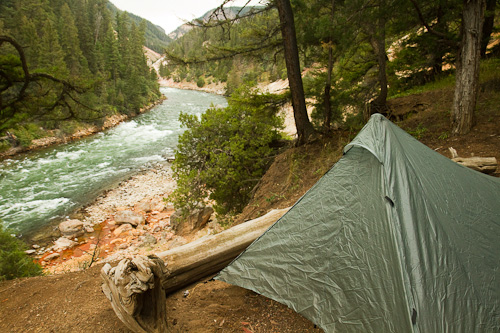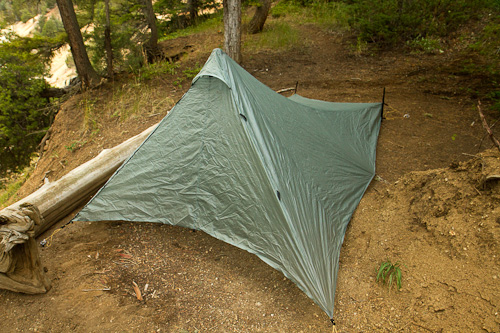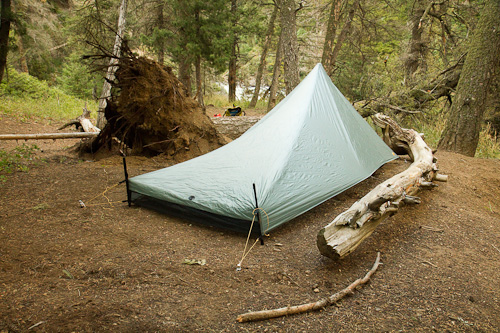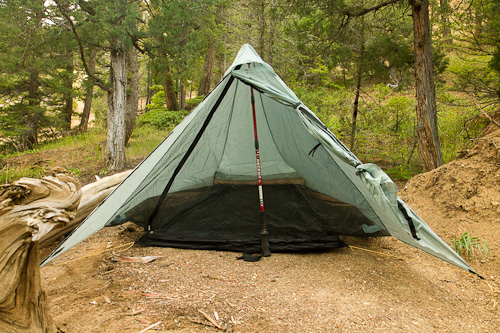TarpTent Contrail review
I generally subscribe to the ultralight backpacking ethos: emphasize on-trail comfort even if it means reduced in-camp comfort. The TarpTent Contrail promised the best of both world, but could it deliver?
For a while, I was using nothing more than a lightweight tarp, a rectangle of ultrathin plastic for a ground cloth, and my sleeping bag while in the backcountry. The problem with that setup is evident in Minnesota: bugs make the night miserable. Many times I would find myself wearing my wide-brimmed hat and mosquito head net while sweating inside my zipped-up bag, all in an effort not to get eaten alive. I became convinced that I had to go to a fully netted solution, even if it meant returning to the land of tents.
Unfortunately, backpacking tents, even solo tents, from major manufacturers tend to be both expensive and disappointingly heavy. One of my friends suggested that I look into the TarpTent line for an alternative.

The TarpTent Contrail in use in Yellowstone’s Seven Mile Hole. That log was there to help me avoid falling down a 40 ft cliff — the river is actually far below the tent.

Front quarter view of the Tarp Tent Contrail
The Good
- Very light. At just 1.5 lbs, this is lighter than nearly every other solo backpacking tent.
- Compact when stowed. This packs so small that it practically disappears in my backpack.
- Works even where there are no trees. Yeah, yeah. I know that fancy hammocks are popular these days. Good luck setting up a hammock without a bunch of trees! The Contrail will go up anywhere that you can drive some stakes, even if there are no trees around.
- Full bug netting. This is the biggest reason why I chose to go with a tent instead of just a tarp. No more swatting mosquitoes at night!
- Hiking pole can be used as the single required pole. No need to carry special-purpose tent poles. I use an REI Shocklight adjustable-length pole.
- Good amount of space in the vestibule. Plenty of room for my boots and pack to stay dry.
- Tall enough for me to sit up inside. Just barely.
- Long enough for me to lay down straight without hitting the walls. I’m 6 ft tall, and that isn’t always a given.

The TarpTent Contrail from the back. The rear struts are adjusted down in this photo: “inclement weather mode”
The Bad
- Slightly complicated to set up. It takes a bit of practice to get the tent set up properly in a reasonable amount of time.
- Slippery floor. The tent instructions suggest painting thick lines of silicone on the floor of the tent while you’re in there sealing the seams. I did that, and while the floor lines helped a bit, I still find my pad sliding around the floor if the tent is on the slightest incline. Perhaps the floor lines need to be even thicker silicone?
- Water comes into the tent if set up incorrectly. Most tents are pretty forgiving when it comes to setup: as long as you’re close, you won’t get wet. Not so with the Contrail. I set up my tent but left the rear struts adjusted high. Then I left to go on a multi-hour hike. It started to rain while I was gone. When I got back, I found a pool of water collected in the “washtub” floor of the tent. At first, I thought that I had ripped a hole somewhere, but further observation showed that the rain was rolling down the roof of the tent to the mesh netting at the back, at which point it was following the netting down to the washtub floor. The fix turned out to be having the bottom of the solid silnylon wall of the tent below the top of the solid silnylon wall of the washtub floor. In other words, make sure the struts are adjusted down.
- Lots of condensation inside. On the same trip as the pooling-water episode, I noticed a lot of condensation building up in the tent at night. What’s more, the rain on the outside would knock the condensation off of the inside, causing a continuous mist to fall in the tent. (At first, I thought the rain itself was getting through the tent walls or seams, but further research showed it was just condensation.) I couldn’t improve ventilation, because that would have let the rain itself back into the tent. I’ve heard that this is a common problem with single-wall tents.

Inside the TarpTent Contrail, being held up by one of my REI hiking poles. Note that the vestibule rolls out of the way when not needed.
Conclusion
The TarpTent Contrail fits my needs for an ultralight solo backpacking tent. It’s light, compact, and very effective at keeping bugs out. I’m a bit disappointed with its performance in the rain, but I’d probably still recommend it.


Recent Comments